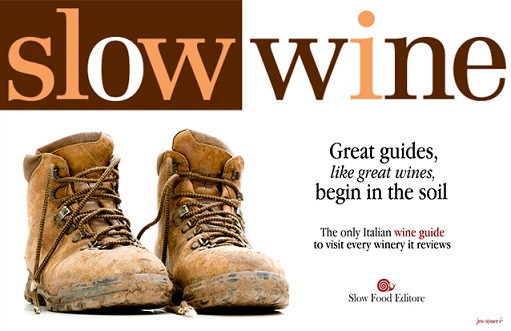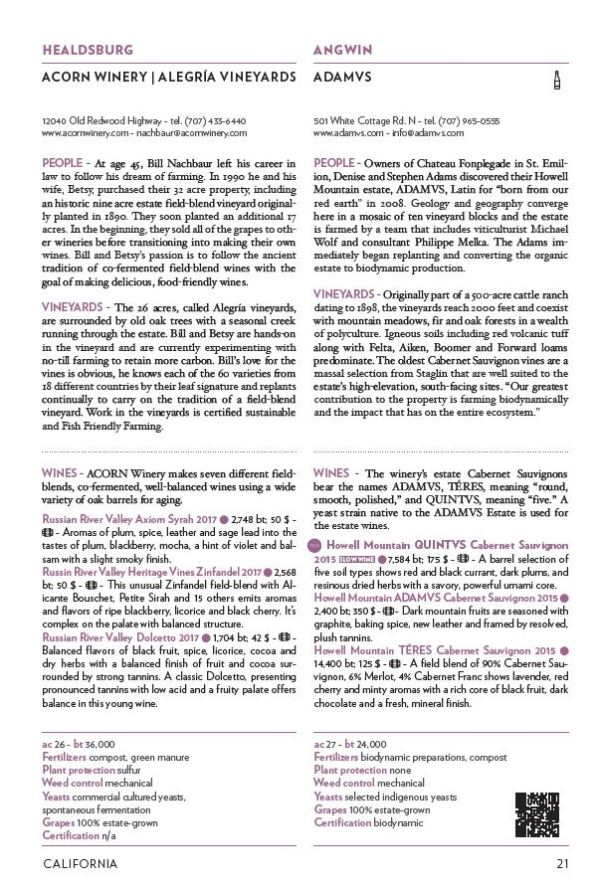
The 2020 Slow Wine USA Guide covers 285 US wineries; Deborah Parker Wong is the US Coordinating Editor
“Speed became our shackles. We fell prey to the same virus: ‘the fast life.'”
“In the name of productivity, the ‘fast life’ has changed our lifestyle and now threatens our environment and our land (and city) scapes.
“Against those – or, rather, the vast majority – who confuse efficiency with frenzy, we propose the vaccine of an adequate portion of sensual gourmandise pleasures, to be taken with slow and prolonged enjoyment.” Carlo Petrini, SLOW FOOD MANIFESTO
Earth Day is Every Day,
so they say.
But it isn’t always easy
to live that way…
Fortunately, there are certifications like CCOF (California Certified Organic Farmer), Demeter (biodynamic), SIP (Sustainability in Practice), Lodi Rules, and more to help us find food and wine that celebrate the slow life.
Not only are organic and biodynamic wines typically better for the planet but they’re better for people too– recent research at UCLA shows that certified wines score significantly higher which you can read about here– and they rarely cost more than conventional commercial wines.
While these various certifications can be confusing (read more about what they mean here in “An Exploration into California Certifications and Sustainable Explanations), they can help us figure out which wineries are paying attention to the triple bottom line of planet, people and profit not just profit.
Wading through labels and websites can be exhausting. How do you decide which wineries to visit? Which wine clubs to join? Which wines to purchase at the supermarket or specialty wine shop?
That’s where wine guides come in handy, like Pam Strayer’s smart phone apps which I wrote about here.
And there’s books like the Slow Wine Guide which has a North American and an Italian edition, published annually each spring.

Of course not in 2020 due to COVID but in 2021 we’ll have our boots on the ground again, says USA Guide coordinating editor Deborah Parker Wong
Slow Wine started in Italy inspired by the Slow Food Movement which began in 1986 after a “demonstration on the intended site of a McDonald’s at the Spanish Steps in Rome.” Since then,the movement advocates “a comprehensive approach to food that recognizes the strong connections between plate, planet, people, politics and culture.”
So how does a winery make the Slow Wine Guide? From Italy, we have The Slow Food Manifesto for Good, Clean, and Fair Wine which suggests a winery:
- grow a minimum of 70% of their grapes, with a few exceptions.
- refuse to use chemically synthesized fertilizers, herbicides or anti-botrytis fungicides
- approach winemaking sustainably
- use “natural” winemaking techniques
- avoid enhancements like oak chips
- use only the low levels of sulfites allowed by the organic standard of the EU
- reflect their place of origin
- encourage biodiversity
- create a supportive community
That’s the Manifesto anyway, and the Slow Wine Guide seeks to find and identify wineries working to meet these goals. At least that’s my understanding of it at this point!

Slow Wine Manifesto from inside the new Guide. Source:Deborah Parker Wong’s
The 2021 US Slow Wine Guide offers entries about three wines from each of 285 wineries located in California, Oregon, Washington, and New York with the US Guide available for the first time in a print edition in a format that looks like this on the page:

Sample page from coordinating editor Deborah Parker Wong’s sneak peek. The QR code links to video interview.
The QR code links you to video interviews that were used instead of visits to the wineries in 2020 due to COVID.
Working with Slow Wine Editor-in-chief Giancarlo Gariglio and Fabio Giavedoni, Deborah Parker Wong serves in the US as the Coordinating Editor with Pam Strayer as Senior Editor. In 2020, twenty field representatives tasted wines and wrote up the entries.
And in 2021, I’ll be one of these field representatives, visiting the wineries, tasting the wines, and selecting wines for awards! Right now I’m responsible for 20 wineries, with more than half of them in Santa Barbara County, and the remainder in Paso Robles, Lodi, and elsewhere. Read more about my background and qualifications here.
Your purchase of the guide makes this important work possible– and this is how you do it! Simply send your name, shipping address and payment to Paypal slowwineguideusa@gmail.com or Venmo @slowwineguideusa.
Hmm, wonder if you could subscribe and order your 2021 copy at the same time?
Because these books make great gifts for the wine lover in your life, consider buying more than one!
Think Moms, Dads, Grads, newlyweds; give a copy, glasses, and a bottle of wine from one the wineries as a gift!
More information here from Deborah Parker Wong.
- 1 copy ($ 22.99 + shipping $ 2.99) $25.98
- 6 copies (19.99 each + shipping $ 5.99) $125.93
Slow Food founder Carlo Petrini said, “If you want to save the world, you must not do it with sadness. You must do it with joy!”
Here’s to wine that brings joy to the world! Cheers!
PS Don’t worry — I’ll still be writing on Wine Predator with Sue’s help and with even more organic and biodynamic wine stories for you so stay tuned! Coming up we have organic and biodynamic Chenin Blanc and Syrah from Reyneke in South Africa, soon we have biodynamic wine from Austria as well as organic and biodynamic wine from Alsace! We also have organic wine from South America prefect for summer time grilling– and I’m hoping to get up a post about organic Prosecco for Mother’s Day. Don’t miss out– subscribe!


Congratulations!! Being part of the Slow Wine Guide seems so right for you!
LikeLiked by 1 person
Thank you Andrea! Six years ago when I first learned about Slow Wine Guide Italy and over the years when I’ve attended the tasting tour in LA and admired the “Snail” wines, I would never have guessed I’d be a regional field rep in CA!
LikeLiked by 1 person
This is awesome. I’m so glad that Deborah and team are taking this to the next level!
LikeLiked by 1 person
Yes! I’m so excited to be part of this project. Thank you for laying the ground work here. And thank you for subscribing! I very much enjoy being a subscriber to your blog, Jeremy.
LikeLike
Yayyy! Auguri, augurissimi, auguroni!
LikeLiked by 1 person
Thank you! You’ve known about these wines for a much longer time than I — and you’ve turned me on to many of the wineries in the book! Thanks, David!
LikeLike